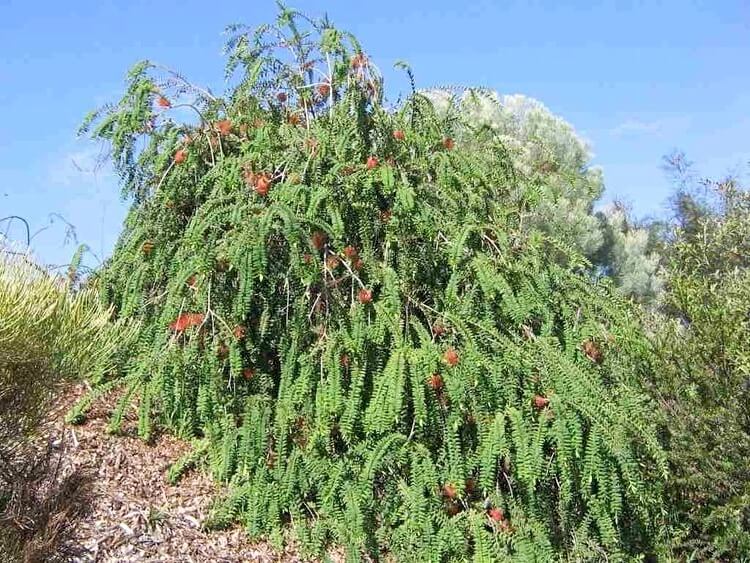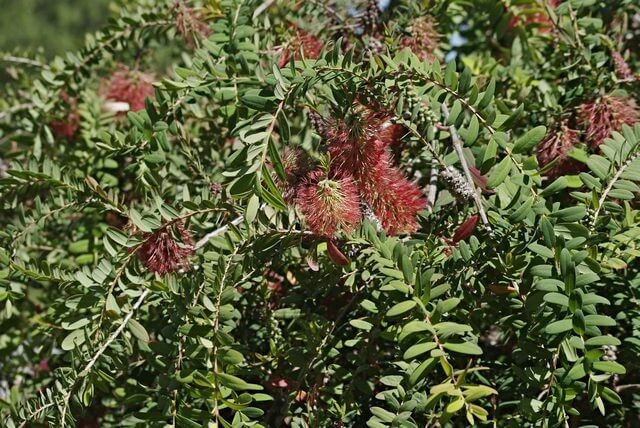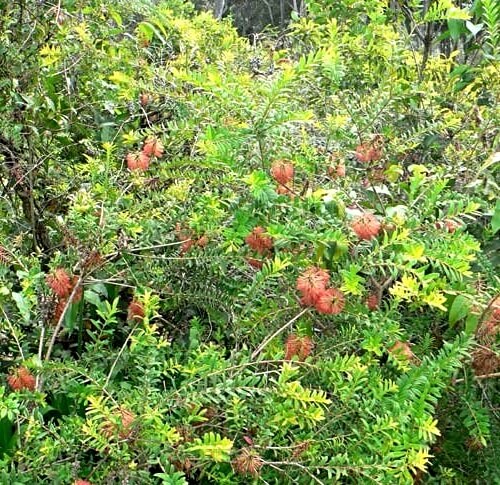Few natives hold a special place in my heart like Melaleuca hypericifolia does. Having grown up with a few in our yard, there’s a certain nostalgic reverence I feel whenever I see one of these proudly Australian shrubs!
From each delicate dance of its branches which are adorned with bright green lanceolate leaves, to the beautiful bursts of colours from its orange to red bottlebrush-like blooms during the summers, the Hillock Bush truly embodies the essence of botanical elegance in Australia.
In today’s comprehensive guide, I’m delighted to share everything you need to know about growing and caring for Melaleuca hypericifolia in your outdoor spaces!
More...
Family: | Myrtaceae |
|---|---|
Genus: | Melaleuca |
Species: | M. hypericifolia |
Common names: | Hillock bush, red-flowered paperbark |
Origin: | Australian native |
Location: | Outdoor |
Type: | Large shrub to small tree |
Growth: | 2 to 6 metres tall, 2 to 3 metres wide |
Sun requirements: | Full sun to light shade |
Foliage colour: | Green (Evergreen) |
Flower colour: | Orange to red flower spikes |
Flowering: | Spring to summer |
Maintenance level: | Moderate |
Poisonous for pets: | Plant oil is toxic to cats, dogs, and horses if consumed |
Being one of the most cultivated of its genus, it is beloved for its large flaming flower spikes, dense foliage, and useful ornamental applications within gardens. Its weeping growth habit can offer some drama to gardens while its evergreen foliage and striking flowers will ensure the shrub looks fantastic year-round!
Melaleuca hypericifolia Plant Info

Source: Alchetron
Botanically named Melaleuca hypericifolia, the shrub's common names include the hillock bush and red-flowered paperbark. It forms part of the Myrtaceae family and is native to the southeast coastal regions of New South Wales where it occurs in the sandy heath and woodland areas from the Bermagui territory to Sydney, and even as far as the Blue Mountains.
Unfortunately, it is now considered an invasive species in South Australia and Victoria so care should be taken before establishing one in those areas.
Hillock Bush Plant Features
When cultivated in gardens, the woody shrub is considered fast-growing, reaching about 2 metres tall and wide, but it can reach up to 6 metres if left to grow in ideal conditions. Depending on your pruning routine and garden conditions, this specimen can also be grown as a small tree.
Regarding its preferred climate, I’ve seen gardeners successfully grow these hardy natives in a wide range of climates so long as you don’t experience hard frosts.
Two noteworthy cultivars have been developed that are ideal for smaller gardens, namely the ‘Snapper Point’ and ‘Ulladulla Beacon’.
Common Uses in Gardens
- Feature plant
- Gap filling
- Container gardening
- Ideal for wildlife gardens that want to attract native bees, butterflies, and nectar-feeding birds
- Its dense foliage makes it an excellent native screening plant
How to Grow Melaleuca hypericifolia
Like other melaleucas, this species is fairly easy to grow from seeds and cuttings. Propagation can take some time and it does require some effort so if you want an easier solution, many reputable Australian nurseries stock young and healthy tubestock plants for this species that can be transplanted into your garden.
Growing Red-Flowered Paperbark from Seeds
Seeds can be purchased online or collected from the woody seed capsules that develop after flowering. This species has good germination rates from seed but I would still recommend sowing a few in case.
- Prepare well-drained seed containers filled with quality seed-raising mix
- Surface sow the seeds in spring or autumn then mist to make the soil moist
- Keep the seeds in a warm and sheltered location like a greenhouse or similar position that gets healthy amounts of indirect light and some ventilation
- Mist the seeds to keep the soil slightly moist at all times
- Allow the seedlings to develop for at least their first winter then they can be transplanted into your garden in spring to early summer
Propagating Hillock Bush from Cuttings
Cuttings are an excellent means of propagating this species for gardens because cuttings will ensure the true-to-type characteristics of the parent plant are maintained.
So, if you have a parent plant that has the ideal form you desire or that flowers prolifically, cuttings will ensure these traits are carried over to the new plant.
- Take softwood cuttings from the current season’s growth from a healthy parent plant
- Cuttings should be at least 12-15cm in length with some leaves and young shoots
- Prepare well-drained propagation containers filled with a quality potting mix or specific propagating soil for cuttings
- Remove the lower leaves from the cuttings then dip the cut-ends into some rooting hormone
- Plant the cuttings into the mixture, planting them upright then gently firming the soil around the stems
- Water well after planting then place the cuttings in a warm and sheltered location that receives bright but indirect light
- Water to keep the soil slightly moist and allow the cuttings to develop roots for their first season before transplanting into the garden
Ideal Conditions for Growing Melaleuca hypericifolia
When grown in good garden conditions, this shrub requires little overall maintenance. However, because of its woody growth and dense habit, moderate maintenance is required annually to keep it thriving and looking its best, especially in smaller outdoor spaces.
Sunlight
As with most flowering shrubs, full sun to light shade is required for this native to look its best. Full sun will allow for better flowering, but the plant can still be grown in more shaded positions in the garden, albeit with fewer flowers.
Ideal Soil
While melaleucas are tolerant to different soil conditions, they do prefer well-drained soil. This particular species prefers sandy or loamy soil types or a sandy-loam soil. For container-grown shrubs, a quality potting mix will work perfectly!
Preferred Climates
Melaleuca hypericifolia is hardy in a wide range of Australian climates so long as you don’t experience hard frosts as the plant is frost hardy down to only -4°C. Temperate to tropical climates are great, with slightly inland coastal climates being ideal.
Plant Spacing
If left to grow large, this species can sport a sizeable trunk with a wide canopy. I advise giving your shrub enough space to grow, especially in suburban gardens. On average, give the shrub at least 2 to 3 metres of surrounding space to avoid any issues.
Caring for Melaleuca hypericifolia
Once established, the hillock bush boasts good resistance to coastal and drought conditions. Overall, minimal care is required to keep this native looking healthy if it is grown in suitable conditions.
Watering Needs
This thirsty shrub will appreciate regular watering, especially while young. It can even withstand boggy spots with less-than-perfect drainage. Water well every week and a little more during hot and dry spells. Supplemental watering can be reduced in winter and during periods of healthy rainfall.
Pruning Hillock Bush
Perhaps one of the most important aspects of caring for this flowering shrub is how you go about pruning it.
Because it flowers off older wood, flowers can become hidden inside the bushy foliage, so pruning is vital to allowing the flowers to be seen! I recommend pruning regularly but lightly during the growing season to maintain a bushy appearance and to display the flowers properly. Try to also prune away any branches growing inwards.
As a quick pro tip, if your shrub needs to be revitalised entirely, it can be cut down to near ground level. This will allow for the total regrowth of healthy and vibrant foliage within some time.
Fertilising Needs
If you feel like your shrub needs a boost, you can opt to fertilise it with a balanced slow-release fertiliser after flowering. A fertiliser for native Australian plants can also work great.
Melaleuca hypericifolia Pests and Diseases
Melaleucas are known to be generally healthy plants that can regularly defend against pests and diseases, especially when grown in Australian gardens. However, one pest that can pose slight issues to this shrub is the webbing caterpillar.
These garden grubs will typically encase themselves in a webbing of foliage and droppings around the inner stems and leaves. This can lead to severe defoliation which will directly impact the appearance of your beautiful shrub.
How to Treat and Remove Webbing Caterpillars
For smaller infestations, you can spray your shrub with an organic neem-oil spray for plants or similar natural insect repellent spray. Alternatively, you can simply cut away the branches that are infested with caterpillars but remember to remove the eggs as well!
For more severe infestations, a more advanced garden pest and insect killer spray may be required. I’d still recommend cutting away all affected branches and foliage to ensure they don’t spread across the entire shrub.
Be sure to dispose of the waste promptly by bagging the branches up and placing them in a suitable bin or off-site entirely.
Melaleuca hypericifolia Frequently Asked Questions

Source: Wildtech Plants
How tall is Melaleuca hypericifolia?
This large woody shrub to small tree grows up to 6 metres tall in its natural habitat. However, when cultivated in gardens, it is more likely to reach about 2 to 3 metres tall and wide.
How do you care for Melaleuca hypericifolia?
In Australia, the species is pretty tolerant to a range of growing conditions, climates, soils, and drainage is not so much of an issue. However, it does require full sun to light shade to grow its best and flower prolifically. It also needs a good prune at least once a year to maintain its bushy appearance.
What are good companion plants for Melaleuca hypericifolia?
The hillock bush will look fantastic planted alongside other flowering natives like callistemons, grevilleas, and Syzygium! If you’re looking for more texture rather than colourful blooms, you can plant some of our gorgeous Australian ferns around as well.
Make the Most of Your Garden's Native Spectacle with Melaleuca hypericifolia!
If you’re looking for your next native flowering shrub, I believe there’s little reason not to consider growing Melaleuca hypericifolia! Whether for its flame-like flowers, its luscious and vivid evergreen foliage, or its ornamental uses in residential gardens, you’re bound to fall in love with this spectacular Australian shrub!
While there are many native shrubs worth considering, Melaleuca hypericifolia will always have a special place in my heart so if you need a native wow factor in your outdoor spaces, this plant may be the perfect pick for you!
Published on October 18, 2023 by Gary Clarke
Last Updated on June 24, 2024





